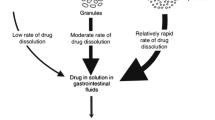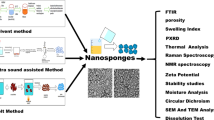Abstract
Zolpidem tartrate is a non-benzodiazepine analogue of imidazopyridine of sedative and hypnotic category. It has a short half-life with usual dosage regimen being 5 mg, two times a day, or 10 mg, once daily. The duration of action is considered too short in certain circumstances. Thus, it is desirable to lengthen the duration of action. The formulation design was implemented by preparing extended-release tablets of zolpidem tartrate using the biphasic delivery system technology, where sodium starch glycolate acts as a superdisintegrant in immediate-release part and hydroxypropyl methyl cellulose as a release retarding agent in extended-release core. Tablets were prepared by direct compression. Both the core and the coat contained the drug. The pre-compression blends were evaluated for angle of repose, bulk density, and compressibility index. The tablets were evaluated for thickness, hardness, weight variation test, friability, and in vitro release studies. No interaction was observed between zolpidem tartrate and excipients from the Fourier transform infrared spectroscopy and differential scanning calorimetry analysis. The results of all the formulations prepared were compared with reference product Stilnoct®. Optimized formulations showed release patterns that match the United States Pharmacopeia (USP) guidelines for zolpidem tartrate extended-release tablets. The mechanism of drug release was studied using different mathematical models, and the optimized formulation has shown Fickian diffusion. Accelerated stability studies were performed on the optimized formulation.





Similar content being viewed by others
REFERENCES
Ellis JG, Perlis ML, Neale LF, Espie CA, Bastien CH. The natural history of insomnia: focus on prevalence and incidence of acute insomnia. J Psychiatr Res. 2012;46:1278–85.
Lacks P, Morin CM. Recent advances in the assessment and treatment of insomnia. J Consult Clin Psychol. 1992;60(4):586–94.
Bogan RK. Treatment options for insomnia—pharmacodynamics of zolpidem extended-release to benefit next-day performance. Postgrad Med. 2008;120(3):161–71.
Zolpidem—compound summary. http://pubchem.ncbi.nlm.nih.gov/summary/summary.cgi?cid=5732. Accessed 11 November 2013.
Zolpidem tartrate: highlights of prescribing information. http://dailymed.nlm.nih.gov/dailymed/lookup.cfm?setid=11a7fa3f-5dd3-4ba6-8a5b-0be321c58dfa. Accessed 11 November 2013.
Colombo P. Swelling-controlled release in hydrogel matrixes for oral route. Adv Drug Delv Rev. 1993;11:37–57.
Martindale WH. The extra pharmacopeia. 30th ed. London: Pharmaceutical Press; 1993. p. 1783.
Sahoo J, Murthy PN, Biswal S, Sahoo SK, Mahapatra AK. Comparative study of propranolol hydrochloride release from matrix tablets with Kollidon®SR or hydroxy propyl methyl cellulose. AAPS Pharm Sci Tech. 2008;9(2):577–82.
Bin C, Joshi SC, Lam YC. Bio-fluid uptake and release of Indomethacin of direct-compressed HPMC tablets. Carbohydr Polym. 2009;75(2):282–6.
Conte U, Maggi L. A flexible technology for the linear, pulsative and delayed release drugs, allowing for easy accommodation of difficult in vitro targets. J Control Release. 2000;64:263–8.
Patel GM, Patel MM. Compressed matrix dual-component vaginal drug delivery system containing metoclopramide hydrochloride. Acta Pharm. 2009;59:273–88.
Doghramji PP. Insomnia: zolpidem extended-release for the treatment of sleep induction and sleep maintenance symptoms. Med Gen Med. 2007;9(1):11.
Monti JM, Spence DW, Perumal SRP, Langer SZ, Hardeland R. Pharmacotherapy of insomnia: focus on zolpidem extended release. Cli Med Ther. 2009;1123–40.
Kirkwood C, Neill J, Breden E. Zolpidem modified-release in insomnia. Neuropsychiatr Dis Treat. 2007;3(5):521–6.
Van Dalen F, Jansen KA, Dorkoosh FA; Synthon Bv. Zolpidem tablets. United States patent 8148393 B2. 2012.
Guo M, Nandi I, Patel A, Wu Ch. Compression coated tablets. United States patent 20040068000 A1. 2004.
Zolpidem tartrate extended release tablets. The United States Pharmacopeial Convention, Revision Bulletin 2012. http://www.usp.org/sites/default/files/usp_pdf/EN/USPNF/revisions/m2061-zolpidem_tartrate_er_tablets.pdf. Accessed: 11 November 2013.
Morre JW, Flanner HH. Mathematical comparison of dissolution profiles. Pharm Technol. 1996;20:64–74.
CDER. Center for Drug Evaluation and Research. Guidance for industry, dissolution testing of immediate release solid oral dosage. 1997. http://www.fda.gov/downloads/Drugs/GuidanceComplianceRegulatoryInformation/Guidances/ucm070237.pdf. Accessed: 11 November 2013.
EMEA. European Agency for the Evaluation of Medicinal Products. Human medicines evaluation unit, note for guidance on quality of modified release products: (A) oral dosage forms; (B) transdermal dosage forms; section I (quality), CPMP/QWP/604/96. 1999. http://www.tga.gov.au/pdf/euguide/qwp060496en.pdf. Accessed: 11 November 2013.
Costa P, Sausa Lobo JM. Modeling and comparison of dissolution profiles. Eur J Pharm Sci. 2001;13:123–33.
Ritger PL, Peppas NA. A simple equation for description of solute release. I. Fickian and non-Fickian release from non-swellable devices in the form of slabs, spheres, cylinders or discs. J Control Release. 1987;5:23–36.
Donbrow M, Samuelov Y. Zero order drug delivery from double-layered porous films: release rate profiles from ethylcellulose, hydroxypropylcellulose and polyethylene glycol mixtures. J Pharm Pharmacol. 1980;32:463–70.
Narashimhan B, Mallapragada SK, Peppas NA. Release kinetics, data interpretation. In: Mathiowitz, editor. Encyclopedia of controlled drug delivery. New York: John Wiley and Sons, Inc; 1999. p. 921.
Silvina A, Bravo M, Lamas C, Claudio J. In-vitro studies of diclofenac sodium controlled-release from biopolymeric hydrophilic matrices. J Pharm Pharmaceut Sci. 2002;5(3):213–9.
Higuchi T. Rate of release of medicaments from ointment bases containing drugs in suspension. J Pharm Sci. 1961;50:874–5.
Higuchi T. Mechanism of sustained-action medication: theoretical analysis of rate of release of solid drugs dispersed in solid matrices. J Pharm Sci. 1963;52:1145–9.
Korsmeyer RW, Gurny R, Doelker EM, Buri P, Peppas NA. Mechanism of solute release from porous hydrophilic polymers. Int J Pharm. 1983;15:25–35.
Peppas NA. Analysis of Fickian and non-Fickian drug release from polymers. Pharm Acta Helv. 1985;60:110–1.
Cox PJ, Khan KA, Munday DL, Sujjareevath J. Development and evaluation of a multiple-unit oral sustained release dosage form for S (+)-ibuprofen: preparation and release kinetics. Int J Pharm. 1999;193:73–84.
Dash S, Murthy PN, Nath L, Chowdhury P. Kinetic modeling on drug release from controlled drug delivery systems. Acta Poloniae Pharm Drug Res. 2010;67(3):217–23.
Siepmann J, Peppas NA. Modeling of drug release from delivery systems based on hydroxypropyl methylcellulose (HPMC). Adv Drug Delv Rev. 2001;48:139–57.
Jacques CHM, Hopfenberg HB, Stannett V. Super case II transport of organic vapors in glassy polymers. In: Hopfenberger HB, editor. Permeability of plastic films and coatings to gases, vapors, and liquids. New York: Plenum Press; 1974. p. 73–86.
Colombo P, Bettini R, Santi P, Peppas NA. Swellable matrices for controlled drug delivery: gel-layer behavior, mechanisms and optimal performance. Pharm Sci Technol Today. 2000;3:198–204.
Maggi L, Machiste EO, Torre ML, Conte U. Formulation of biphasic release tablets containing slightly soluble drugs. Eur J Pharm Biopharm. 1999;48:37–42.
ACKNOWLEDGMENTS
The authors are grateful to M/s. Anglo-French Drugs and Industries Ltd. (Bangalore, India) for providing necessary facilities to carry out this research work.
Author information
Authors and Affiliations
Corresponding author
Rights and permissions
About this article
Cite this article
Mahapatra, A.K., Sameeraja, N.H. & Murthy, P.N. Development of Modified-Release Tablets of Zolpidem Tartrate by Biphasic Quick/Slow Delivery System. AAPS PharmSciTech 16, 579–588 (2015). https://doi.org/10.1208/s12249-014-0236-2
Received:
Accepted:
Published:
Issue Date:
DOI: https://doi.org/10.1208/s12249-014-0236-2




